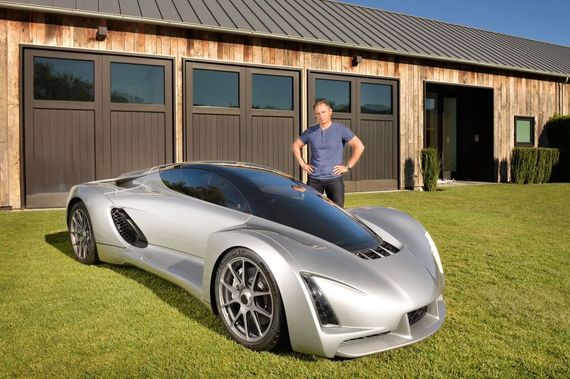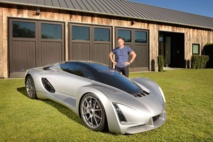Vehicle DM, called Blade, is built on a chassis that is 90% lighter than conventional designs of vehicles. The two-seater has tandem landing and guillotine doors weighs 635 kg; with an engine of 700 h.p., it can accelerate to 60 miles/h (96 km/h) in about 2 seconds. The company plans build the plant to fulfill a technique for the production of the car over the next 1.5 years, and then sell the manufacturing technology to other entrepreneurs, who are able to raise $ 10 million to establish their own industries for the manufacture of the vehicle, said founder and CEO Kevin Czinger.
DM, like Local Motors, relies on 3D-print in order to avoid the high costs of stamping equipment for the manufacture of car chassis. A technique known as "layering capacity" is superimposed layers of material, in this case aluminum, to form a part.
Blade is based on a spatial frame of hollow aluminum components - structural connectors, manufactured by 3D-printing, which are bonded in between with carbon-fiber rods. The design creates a light and elastic body, which can be briskly assembled in any room without special tools. Companies, obtained a license for the technology, can buy most of the other components from local suppliers, and using a modular design, build their vehicles, says Czinger.
Earlier this year, Local Motors unveiled a prototype of its own car entirely manufactured by 3D-printing, including the chassis and the outer shell. The car is also designed to be build up on local enterprises using components from different vendors. The cost of creating a local manufacturing could be $ 10-20 million, according to Local Motors Chief Strategy Officer Justin Fishkin. The plant in Knoxville, Tennessee, which is being built for the production of the printed car, is designed for output to break even in the production of 2400 cars per year, he says.
Mini-mills that use 3D-press, among other methods of production, began to attract the attention of business due to the rapid reduction of hardware costs. The big advantage is their low capital, says an expert on the production of PA Consulting Tim Lawrence.
- Creation of production and assembly lines, as well as special tools, require huge amounts of investment. 3D-printing is an extra technology, you do not have to be squeezed out for tools, so that you do not much need of capital equipment, he says.
Layered capacity is widely used in the aerospace industry and some manufacturers of Formula 1 cars. But the technology is too slow to be grafted in the mass automotive industry where its use is restricted to the stages of pre-production. Automakers are using 3D-press to create a sample of plastic components, such as inside door handles, loudspeakers grilles and air inlets, as well as for a variety of metal parts. Some cars with small production volumes are equipped with components made by 3D-printing techniques, such as the Swedish Koenigsegg’s hypercar produced turbine engine this way.
Nevertheless, the use of the technology in mass production is seen as a distant prospect. For plants producing hundreds of thousands of vehicles per year, the usual methods of cars production are faster and more cost-effective.
Czinger, co-founder of the Coda Automotive manufacture went bankrupt in 2013, says that the experience prompted him to seek new and more flexible forms of production, after the high cost of tooling for Coda machinery had resulted in that they could not fairly quickly respond to the changing circumstances. Layered capacity also creates greater variety and opportunities for consumer individualization without increasing manufacturing costs for the producer, what can significantly change the spare parts market.
source: ft.com
DM, like Local Motors, relies on 3D-print in order to avoid the high costs of stamping equipment for the manufacture of car chassis. A technique known as "layering capacity" is superimposed layers of material, in this case aluminum, to form a part.
Blade is based on a spatial frame of hollow aluminum components - structural connectors, manufactured by 3D-printing, which are bonded in between with carbon-fiber rods. The design creates a light and elastic body, which can be briskly assembled in any room without special tools. Companies, obtained a license for the technology, can buy most of the other components from local suppliers, and using a modular design, build their vehicles, says Czinger.
Earlier this year, Local Motors unveiled a prototype of its own car entirely manufactured by 3D-printing, including the chassis and the outer shell. The car is also designed to be build up on local enterprises using components from different vendors. The cost of creating a local manufacturing could be $ 10-20 million, according to Local Motors Chief Strategy Officer Justin Fishkin. The plant in Knoxville, Tennessee, which is being built for the production of the printed car, is designed for output to break even in the production of 2400 cars per year, he says.
Mini-mills that use 3D-press, among other methods of production, began to attract the attention of business due to the rapid reduction of hardware costs. The big advantage is their low capital, says an expert on the production of PA Consulting Tim Lawrence.
- Creation of production and assembly lines, as well as special tools, require huge amounts of investment. 3D-printing is an extra technology, you do not have to be squeezed out for tools, so that you do not much need of capital equipment, he says.
Layered capacity is widely used in the aerospace industry and some manufacturers of Formula 1 cars. But the technology is too slow to be grafted in the mass automotive industry where its use is restricted to the stages of pre-production. Automakers are using 3D-press to create a sample of plastic components, such as inside door handles, loudspeakers grilles and air inlets, as well as for a variety of metal parts. Some cars with small production volumes are equipped with components made by 3D-printing techniques, such as the Swedish Koenigsegg’s hypercar produced turbine engine this way.
Nevertheless, the use of the technology in mass production is seen as a distant prospect. For plants producing hundreds of thousands of vehicles per year, the usual methods of cars production are faster and more cost-effective.
Czinger, co-founder of the Coda Automotive manufacture went bankrupt in 2013, says that the experience prompted him to seek new and more flexible forms of production, after the high cost of tooling for Coda machinery had resulted in that they could not fairly quickly respond to the changing circumstances. Layered capacity also creates greater variety and opportunities for consumer individualization without increasing manufacturing costs for the producer, what can significantly change the spare parts market.
source: ft.com



















